Today starts the 10th Women and the Silent Screen Conference, hosted by Eye Filmmuseum in Amsterdam. On 8 March, International Women's Day, EFSP had a post with 20 American women who both worked in front of and behind the camera during the silent film era, and whose profile can be found at Women Pioneers Film Project. Part 2 of our post focusses on 20 European women film pioneers. WFPP does not have entries on all the women in this post. Some ladies are still on their wish-list, and of one, Elena Sangro, we think she deserves to be on the list. EFSP's co-editor Ivo Blom selected 20 female film pioneers from as many nationalities as we could find postcards of.

Sarah Bernhardt. French postcard. Sarah Bernhardt in Edmond Rostand's play L'Aiglon. The title role for Rostand's play was created by Bernhardt herself in the play's premiere on 15 March 1900 at the Théàtre Sarah Bernhardt in Paris.
Victoria Duckett at Women Pioneer Film Project: "She was among the first celebrities to engage with the motion picture, playing Hamlet in a one-minute film that formed part of Paul Decauville’s program for the Phono-Cinéma-Théâtre at the Paris Exposition of 1900. The first feature film that she released – Camille (1911) – was promoted the following year by the French American Film Company in Moving Picture World as “Making New Records for Selling States Rights”. A subsequent advertisement in the same trade press claimed that the film was “The Fastest Seller Ever Offered State Right Buyers”. As many film historians know, Bernhardt’s Queen Elizabeth (1912) was the Famous Players Company’s first release in the U.S. It similarly enjoyed success, helping to open the market for legitimate motion picture exhibition in the U.S. Queen Elizabeth thereby provided audiences with their first experience of the longer-playing narrative feature film."

Francesca Bertini. American postcard, monogram K Ltd. Francesca Bertini in Odette (Giuseppe De Liguoro, 1916).
Monica Dall’Asta at Women Pioneer Film Project : "Bertini’s different autobiographical interventions are consistent in reclaiming a creative as well as managerial role in the production of all her major star vehicles. Especially in the long interview recorded by Mingozzi, she credits herself not just for obtaining the rights to adapt 'Assunta Spina' from Di Giacomo, but, more importantly, she argues for directorial recognition for that film. This claim was later confirmed in a 1981 interview with her co-star, and the official director of the film, Gustavo Serena."

Carmen Cartellieri. Austrian postcard by Iris Verlag, no. 989. Photo: Residenz Atelier, Wien.
Robert von Dassanowsky at Women Pioneer Film Project: "Carmen Cartellieri was born Franziska Ottilia Cartellieri in Prossnitz, Austria-Hungary, which is today Prostejov, Czech Republic, but spent her childhood in Innsbruck, Austria. In 1907, at age sixteen, she married the aristocratic artist-turned-director, Emanuel Ziffer Edler von Teschenbruck. Her husband and Cornelius Hintner, a cameraman from South Tyrol who had worked for Pathé in Paris and then as a director in Hungary, helped make her one of the most fashionable stars in German-language film of the 1920s. Using the stage name of Carmen Teschen, she appeared in several Hungarian silent films between 1918 and 1919 and made her Austrian film debut in Hintner’s Die Liebe vom Zigeunerstamme/The Gypsy Girl (1919), which she reportedly cowrote. Political changes in postwar Hungary made her relocate to Vienna where she returned to her exotic surname, suggesting to the press that she was born in Italy, and founded the Cartellieri-Film company in 1920 with her husband and Hintner."

Aud Egede Nissen. German postcard by Ross Verlag, no. 476/1, 1919-1924. Photo: A. Eberth, Berlin.
Gunnar Iversen at Women Pioneer Film Project: "During the 1910s and 1920s, Aud Egede-Nissen and her sisters Gerd and Ada made a name for themselves in the Nordic and German film industries as actors, producers, and directors. Like many female pioneers in the film industry, their work has been neglected. The contribution of the Egede-Nissen sisters, especially Aud, to silent film in the 1910s is remarkable given the odds they had to overcome as female producers in a male-dominated industry and the lack of tradition and experience in their home country, Norway."
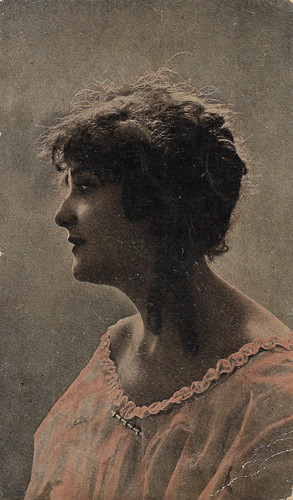
Fabienne Fabrèges. Spanish postcard by Chocolate Salas-Sabadell.
Elena Nepoti at Women Pioneer Film Project: "Her film career, between 1910 and the mid-1920s, can be divided into three periods. Between 1910 and 1916, the actress worked in France for the Société des Établissements Gaumont. During World War I, she relocated to Italy, where she was immediately recognized as a leading actress by the Italian film industry, and, between 1916 and 1923, acted in two dozen films. In many of these films she is credited as the screenwriter, and for one of them, also as the director. Finally in the twenties she left the stage and screen in Italy and most likely moved to England, where it seems she carried out some further stage work, and then her career seems to have come to an end."
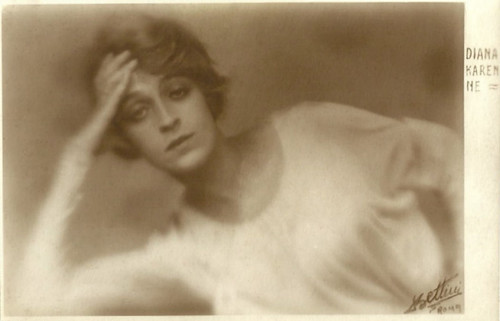
Diana Karenne. Italian postcard by Ed. Soc. Anon. It. Bettini, Roma.
Cristina Jandelli, Linda Del Gamba at Women Film Pioneer Project: "Diana Karenne was one of the most interesting personalities in the Italian and European film scenes of the early 1900s. Star, actress, intellectual, artist, director, screenwriter, and producer, she is representative of an effectual coexistence between two different ways of considering a woman’s role in both the film industry and in a society that was undergoing deep changes as to gender boundaries. Through her artistic career, she supported demands concerning female identity, widely felt between 1800 and 1900: in this very period, Europe was facing a process of modernization and large transformations at every social level. Karenne never took sides towards women’s emancipation movements, yet she opposed conservative morals and social conventions of that time through her personal, aesthetic, and professional choices, and helped to update the idea of cinema thanks to her bold artistic proposals and acting style."
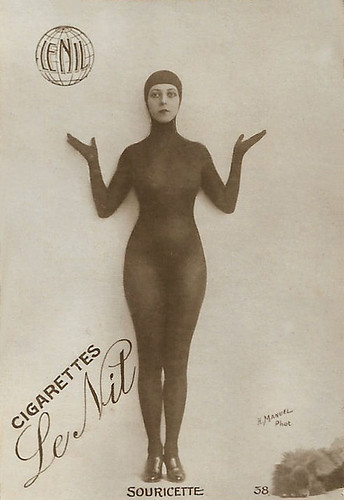
Musidora. French cigarette card by Cigarettes Le Nil, no. 38. Photo: H. Manuel.
Annette Förster at Women Film Pioneer Project: "If we merely looked at contemporary advertisements and reviews, it would appear that Musidora had directed only two films in the silent era: Vicenta (1919), and La terre des taureaux/The Land of the Bulls (1924). These credits can be further substantiated by personal statements about the making of these films published by Musidora herself in contemporary periodicals. There, she additionally claimed credit for writing both scripts as well as for editing La terre des taureaux. However, on the two other films that were produced under the banner of her company, Société des Films Musidora, she credited as director her codirector Jacques Lasseyne. Even the richly illustrated publicity booklets of Pour Don Carlos/For Don Carlos (1921) and Soleil et ombre/Sun and Shadow (1922) listed Musidora only in the cast, and her article in the magazine Ève bore the telling title 'Comment j’ai tourné Don Carlos' or 'How I Acted in Don Carlos'. After the 1940s, however, Musidora began to claim the codirector and adaptation credits of these productions for herself, and these credits have now been accepted as definitive. Additionally, she added the credit for codirection, with Roger Lion, for La flamme cachée/The hidden flame (1918), which she mentioned in a 1950 article on her professional collaboration with her artistic mentor and longtime friend, Colette."
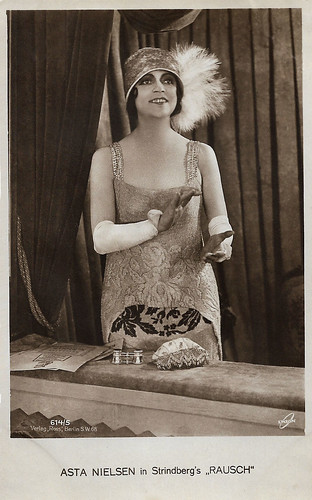
Asta Nielsen. German postcard by Ross Verlag, no. 614/5. Photo: Union. Publicity still for Rausch/Intoxication (Ernst Lubitsch, 1919).
Julie Allen at Women Film Pioneer Project: "Frequently lauded as 'die Duse des Kinos' [the Duse of the cinema], as Poul Elsner noted in Weltrundschau in 1911, the Danish actress Asta Nielsen was the first major star of German silent film. She acted in more than seventy films, all but four of them made with German production companies, during the twenty-two years of her film career. The phenomenal success of her debut film, Afgrunden/The Abyss (1910) enabled her to become the first global film star under the new monopoly distribution system. From 1910 to 1914, she collaborated closely with director Urban Gad, who was also her first husband, under the auspices of Deutsche Bioscop and Projektions-AG “Union” (PAGU), and later established two film companies of her own. Although she struggled to come to terms with the director-centric turn of the film industry in Germany in the 1920s that restricted the artistic autonomy she had enjoyed in the 1910s, she made several of her most artistically impressive films, including several Weimar street films, during this period. In 1932, she acted in her only sound film, Unmögliche Liebe/Impossible Love, which was also her final film, aside from two documentaries about her made decades later."
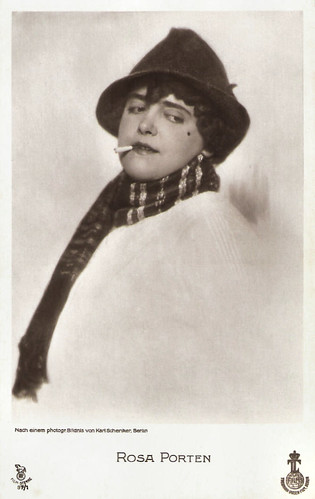
Rosa Porten. German postcard in the Film Sterne series by Rotophot, no. 97/1. Photo: Karl Schenker, Berlin / Treumann- Larsson Film, Berlin.
Annette Förster at Women Film Pioneer Project: "Rosa Porten’s work as a screenwriter, an actress, and a film director has been practically neglected in film history, but what she accomplished in the German silent cinema is truly noteworthy. In a two-decade career, from 1906 until 1928, she created a cinematic oeuvre that was substantial, original, versatile, and entertaining. The exact number of films to which Rosa Porten contributed is uncertain, but historical substantiation points to around forty titles. Between 1916 and 1919 alone, she wrote and co-directed at least twenty-four catching comedies and gripping social dramas and in most of them she played the protagonist. Even more notable in retrospect is that Porten’s stories often privileged the perspective of a female character who, with non-conformist pragmatism or jokey recalcitrance, seizes her chance to defy bourgeois conventions and role patterns."

Anny Ondrakova/Ondra. German postcard by Ross Verlag, no. 4250/1, 1929-1930.
Anny Ondra (1903-1987) was born as Anna Sophie Ondráková in Tarnów, Austria-Hungary, now Poland.. During the 1920s and 1930s she was a popular actress in Czech, Austrian and German comedies, and she was Alfred Hitchcock’s first ‘Blonde’. She was discovered at the age of 16 bij actor-director Karel (or Carl) Lamac. They starred together in the film Palimpsest (Joe Jencik, 1919). Lamac would also become her first husband. From 1919 on Anny Ondra often worked together with Lamac as her director and/or her co-star dor their own production company. With their film Gilly po prve v Praze/Gilly zum ersten Mal in Prag/Gilly for the First Time in Prague (Carl Lamac, 1920) she became a big comedy star in the silent Czechoslovakian and Austrian cinema.
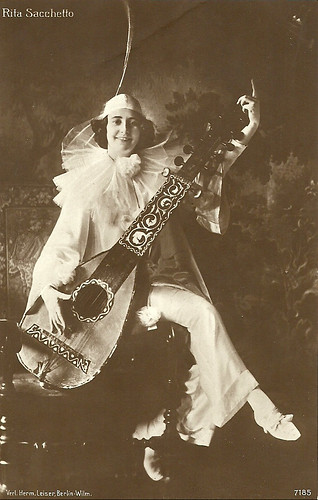
Rita Sacchetto. German Postcard by Verlag Hermann Leiser, Berlin, no. 7185. Collection: Didier Hanson.
German actress and dancer Rita Sacchetto (1879-1959) was in the 1910s a star of the Danish Nordisk Film Company. Nordisk had hired Sacchetto to star in films for the astonishing salary of 7,000 kroner per picture, but she made many quite successful films including Fra Fryste til Knejpevaert/The Gambler's Wife (Holger-Madsen, 1913) and Den Skønne Evelyn/Evelyn the Beautiful (A.W. Sandberg, 1916) with a script by Carl Theodor Dreyer. According to Karl Toepfer in his study 'Empire of Ecstasy: Nudity and Movement in German Body Culture, 1910-1935' "Sacchetto exuded a dusky, melancholy beauty that seemed even more refined and aristocratic, a 'breeze of perfume,' when displayed in opulent historical costumes. Although she excluded modern paintings of women from her graceful productions, she was probably the first to use silent film as a model for composing dances."

Fern Andra. German postcard by Rotophot in the Film Sterne series, no. 512/6. Photo: Fern Andra Atelier. Fern Andra in Eine Motte flog zum Licht (Fern Andra, 1915).
'Modern' American Fern Andra (1893-1974) became one of the most popular film stars of the German cinema in the 1910s and early 1920s. In her films she mastered tightroping, riding a horse without a saddle, driving cars and motorcycles, bobsleighing, and even boxing. She started her own company, even directing her own films. Right during the First World War, Fern made one film after another, always about women who are victims of cruel events but who are also determined to settle matters. These films included Eine Motte floh zum Licht/A Moth Flew To The Light (Fern Andra, 1915), and Drohende Wolken am Firmament/Threatening Clouds in the Sky (Fern Andra, 1918). Moonlight romance, theatres burning down, and luxurious parties in aristocratic milieux. Unfortunately most of these films were never exported because of the war, and most are lost now.
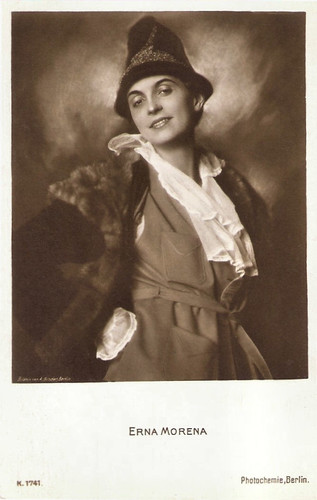
Erna Morena. German postcard by Photochemie, no. K . 1741. Photo: Alex Binder, Berlin.
Although her name is now largely forgotten, Erna Morena (1885-1962) appeared in about 120 films during five decades. She had an enormous career in the German silent cinema of the 1910s and 1920s as both an actress, producer and screenwriter, and until the mid-1930s she was regularly performing in German sound films. In 1918 she founded in Berlin, Erna Morena Film GmbH, supported by some friends as partners. She produced films like Colomba (1918) with Werner Krauss, and Die 999. Nacht/The 999th Night (1919/1920) with Hans Albers. Because of the economic crisis after the German November revolution of 1918-1919, she had to stop producing after two years.
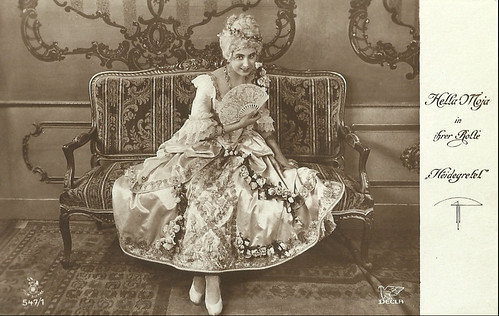
Hella Moja. German postcard in the Film-Sterne series by Rotophot, no. 547/1. Hella Moja in the German silent film Heide-Gretel (Otto Rippert, 1918), produced by the Decla-Filmgellschaft (Eric Pommer).
During the First World War and the following years Hella Moja (1890-1951) was one of the most popular stars of the German silent cinema. There was even a Hella Moja serial and in 1918 she founded her own film company. The Hella Moja Filmgesellschaft would produce 16 films. Her first production was Wundersam ist das Märchen der Liebe/Wondrous is the Fairy Tale of Love (Leo Connard, 1918) with Ernst Hofmann, for which the critics especially praised her acting. Another successful production was Die Augen von Jade/The Eyes of Jade (Iwa Raffay, 1918). In Figaros Hochzeit/The Marriage of Figaro (Max Mack, 1920) based on the play by Pierre Augustin Caron de Beaumarchais, she was again impressive as Cherubino - Figaros page opposite Alexander Moissi as Figaro.

Wanda Traumann. German postcard in the Film Sterne series by Rotophot, no. 85/3. Photo: Karl Schenker / Messter Film, Berlin.
Wanda Traumann (1889–1926) belonged to the most popular stars of the German cinema before the first World War. In 1912, together with actor-director Viggo Larsen and her husband, Karl Treumann, she founded her own production company Treumann-Larsen Film GmbH in Berlin. Officially, Wanda Treumann’s husband was indicated as owner of the firm. As she said herself in Lichtbild-Theater, no. 41, 1912: "Then we – my master and partner in film, Mr. Oberregisseur Viggo Larsen and me – became fully independent. And so we are now: for the production of our new 'Treumann-Larsen-series', we develop the negatives ourselves which we shoot in our own film studio with our own cast and crew."

Olga Tschechowa. German postcard by Ross Verlag, no. 1590/3, 1927-1928. Photo: Ufa.
Dignified German-Russian actress Olga Tschechowa (1897-1980) was one of the most popular stars of the silent film era. She played in more than 40 silent films, including the classic comedy Un Chapeau de Paille d'Italie/An Italian Straw Hat (René Clair, 1927), Moulin Rouge (Ewald André Dupont, 1928), and Diane (Erich Waschneck, 1929), which was produced by her own company Tschechowa Film. She remained a mysterious person throughout her life, and was reportedly a Russian agent in Nazi Germany.

Former Kingdom of Yugoslavia (now Croatian) postcard. Photo: Croatia Film. Jugoslavija Film, Zagreb, No. 11. Milica Mihicic, Zorka Grund and Bogumila Vilhar in the film Dvije sirote/ Dvije sirotice/The Two Orphans (Alfred Grinhut [listed as Alfred Grünhut], 1919), starring Zorka Grund. The film is based on the famous French play 'Les deux orphelines' by Adolphe d'Ennery and Eugène Cormon (1874).
Zorka Kremzar, born Zorka Grund (1900 -?), was a Croatian film actress. She was the daughter of Arnošt Grund, a director of Czech origin, and sister of Milada Grund, who performed under the pseudonym of Milada Tana. Zorka Grund later became a filmmaker.
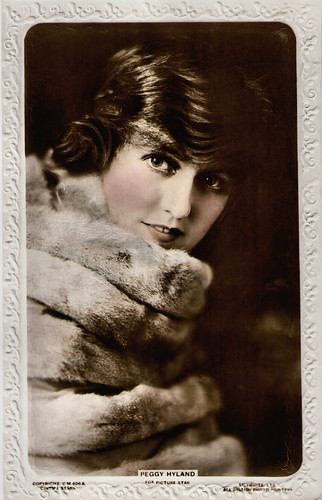
Peggy Hyland. British postcard in the Lilywhite Photographic series, no. CM 406a. Photo: William Fox.
Peggy Hyland (1884–1973) was an English film actress and director, who starred in more than 45 British and American silent films. She remained active in films until 1925. Peggy Hyland's film credits number more than forty-five, in both British and American productions. Hyland wrote, produced, directed and starred in With Father's Help (Peggy Hyland, 1922) and she directed and starred in The Haunted Pearls (Peggy Hyland, 1924).

Elena Sangro. Italian postcard by Ed. A. Traldi, Milano, no. 714. Elena Sangro as Proserpina, wife of Pluto, king of the underworld, in the Italian silent film Maciste all'inferno/Maciste in Hell (Guido Brignone, 1925).
Elena Sangro (1896-1969) was one of the main actresses of the Italian cinema of the 1920s. In spite of the general film crisis then, she made one film after another. She was also one of the first female directors and she had a famous affair with the novelist, poet and playwright Gabriele D'Annunzio. Her last film appearance was a cameo in Federico Fellini's masterpiece 8½ (1963). Her last job was president of Associazione dei Pionieri del Cinema, an initiative begun in the early 1960s in order to saveguard this important part of film history.
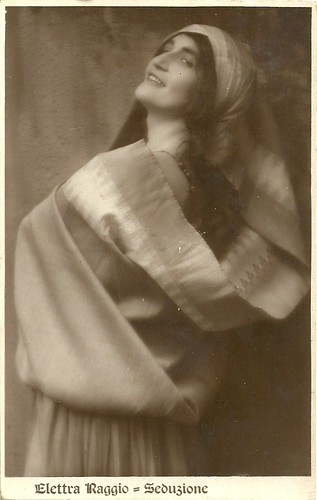
Elettra Raggio. Italian postcard. Elettra Raggio in the Italian silent film SeduzioneSeduction (1915). This title does not exist in the reference works, only the title Le due seduzioni/The Two Seductions (1916) which Raggio directed and in which she had the female lead as well, opposite Giovanni Donadio and Felice Minotti.
Elettra Raggio, pseudonym of Ginevra Francesca Rusconi (1887–1973), was an Italian film actress, director, scriptwriter and producer of the silent era. Raggio came from the theatre where she was 'first actress' in the company of Ermete Novelli. Of Genovese origin, she settled in Milan where she was hired in 1915 by the film production company Milano Films. There she acted in Verso l'arcobaleno/Towards the Rainbow (Eugenio Perego, 1916) - about a Belgian family menaced by the German invasion, the sensational film La cattiva stella/The Bad Star (Eugenio Perego, 1916) about a millionnaire (Ugo Gracci) who trades identity with a drowned man. In the same year, Raggio directed her first film at Milano: Le due seduzioni/The Two Seductions (1916), which she also scripted and produced. Also in 1916, Raggio founded her own film company within the aegis of Milano Film, which operated as distributor for Raggio Film. She produced two films. First came the poetic phantasy Primavera/Spring (Achille Mauzan, 1916), and then the romantic comedy Galeotto fu il mare.../The Sea was such a Lovemaker (Achille Mauzan, 1916. Mauzan also designed the posters for both films.

Sarah Bernhardt. French postcard. Sarah Bernhardt in Edmond Rostand's play L'Aiglon. The title role for Rostand's play was created by Bernhardt herself in the play's premiere on 15 March 1900 at the Théàtre Sarah Bernhardt in Paris.
Victoria Duckett at Women Pioneer Film Project: "She was among the first celebrities to engage with the motion picture, playing Hamlet in a one-minute film that formed part of Paul Decauville’s program for the Phono-Cinéma-Théâtre at the Paris Exposition of 1900. The first feature film that she released – Camille (1911) – was promoted the following year by the French American Film Company in Moving Picture World as “Making New Records for Selling States Rights”. A subsequent advertisement in the same trade press claimed that the film was “The Fastest Seller Ever Offered State Right Buyers”. As many film historians know, Bernhardt’s Queen Elizabeth (1912) was the Famous Players Company’s first release in the U.S. It similarly enjoyed success, helping to open the market for legitimate motion picture exhibition in the U.S. Queen Elizabeth thereby provided audiences with their first experience of the longer-playing narrative feature film."

Francesca Bertini. American postcard, monogram K Ltd. Francesca Bertini in Odette (Giuseppe De Liguoro, 1916).
Monica Dall’Asta at Women Pioneer Film Project : "Bertini’s different autobiographical interventions are consistent in reclaiming a creative as well as managerial role in the production of all her major star vehicles. Especially in the long interview recorded by Mingozzi, she credits herself not just for obtaining the rights to adapt 'Assunta Spina' from Di Giacomo, but, more importantly, she argues for directorial recognition for that film. This claim was later confirmed in a 1981 interview with her co-star, and the official director of the film, Gustavo Serena."

Carmen Cartellieri. Austrian postcard by Iris Verlag, no. 989. Photo: Residenz Atelier, Wien.
Robert von Dassanowsky at Women Pioneer Film Project: "Carmen Cartellieri was born Franziska Ottilia Cartellieri in Prossnitz, Austria-Hungary, which is today Prostejov, Czech Republic, but spent her childhood in Innsbruck, Austria. In 1907, at age sixteen, she married the aristocratic artist-turned-director, Emanuel Ziffer Edler von Teschenbruck. Her husband and Cornelius Hintner, a cameraman from South Tyrol who had worked for Pathé in Paris and then as a director in Hungary, helped make her one of the most fashionable stars in German-language film of the 1920s. Using the stage name of Carmen Teschen, she appeared in several Hungarian silent films between 1918 and 1919 and made her Austrian film debut in Hintner’s Die Liebe vom Zigeunerstamme/The Gypsy Girl (1919), which she reportedly cowrote. Political changes in postwar Hungary made her relocate to Vienna where she returned to her exotic surname, suggesting to the press that she was born in Italy, and founded the Cartellieri-Film company in 1920 with her husband and Hintner."

Aud Egede Nissen. German postcard by Ross Verlag, no. 476/1, 1919-1924. Photo: A. Eberth, Berlin.
Gunnar Iversen at Women Pioneer Film Project: "During the 1910s and 1920s, Aud Egede-Nissen and her sisters Gerd and Ada made a name for themselves in the Nordic and German film industries as actors, producers, and directors. Like many female pioneers in the film industry, their work has been neglected. The contribution of the Egede-Nissen sisters, especially Aud, to silent film in the 1910s is remarkable given the odds they had to overcome as female producers in a male-dominated industry and the lack of tradition and experience in their home country, Norway."

Fabienne Fabrèges. Spanish postcard by Chocolate Salas-Sabadell.
Elena Nepoti at Women Pioneer Film Project: "Her film career, between 1910 and the mid-1920s, can be divided into three periods. Between 1910 and 1916, the actress worked in France for the Société des Établissements Gaumont. During World War I, she relocated to Italy, where she was immediately recognized as a leading actress by the Italian film industry, and, between 1916 and 1923, acted in two dozen films. In many of these films she is credited as the screenwriter, and for one of them, also as the director. Finally in the twenties she left the stage and screen in Italy and most likely moved to England, where it seems she carried out some further stage work, and then her career seems to have come to an end."

Diana Karenne. Italian postcard by Ed. Soc. Anon. It. Bettini, Roma.
Cristina Jandelli, Linda Del Gamba at Women Film Pioneer Project: "Diana Karenne was one of the most interesting personalities in the Italian and European film scenes of the early 1900s. Star, actress, intellectual, artist, director, screenwriter, and producer, she is representative of an effectual coexistence between two different ways of considering a woman’s role in both the film industry and in a society that was undergoing deep changes as to gender boundaries. Through her artistic career, she supported demands concerning female identity, widely felt between 1800 and 1900: in this very period, Europe was facing a process of modernization and large transformations at every social level. Karenne never took sides towards women’s emancipation movements, yet she opposed conservative morals and social conventions of that time through her personal, aesthetic, and professional choices, and helped to update the idea of cinema thanks to her bold artistic proposals and acting style."

Musidora. French cigarette card by Cigarettes Le Nil, no. 38. Photo: H. Manuel.
Annette Förster at Women Film Pioneer Project: "If we merely looked at contemporary advertisements and reviews, it would appear that Musidora had directed only two films in the silent era: Vicenta (1919), and La terre des taureaux/The Land of the Bulls (1924). These credits can be further substantiated by personal statements about the making of these films published by Musidora herself in contemporary periodicals. There, she additionally claimed credit for writing both scripts as well as for editing La terre des taureaux. However, on the two other films that were produced under the banner of her company, Société des Films Musidora, she credited as director her codirector Jacques Lasseyne. Even the richly illustrated publicity booklets of Pour Don Carlos/For Don Carlos (1921) and Soleil et ombre/Sun and Shadow (1922) listed Musidora only in the cast, and her article in the magazine Ève bore the telling title 'Comment j’ai tourné Don Carlos' or 'How I Acted in Don Carlos'. After the 1940s, however, Musidora began to claim the codirector and adaptation credits of these productions for herself, and these credits have now been accepted as definitive. Additionally, she added the credit for codirection, with Roger Lion, for La flamme cachée/The hidden flame (1918), which she mentioned in a 1950 article on her professional collaboration with her artistic mentor and longtime friend, Colette."

Asta Nielsen. German postcard by Ross Verlag, no. 614/5. Photo: Union. Publicity still for Rausch/Intoxication (Ernst Lubitsch, 1919).
Julie Allen at Women Film Pioneer Project: "Frequently lauded as 'die Duse des Kinos' [the Duse of the cinema], as Poul Elsner noted in Weltrundschau in 1911, the Danish actress Asta Nielsen was the first major star of German silent film. She acted in more than seventy films, all but four of them made with German production companies, during the twenty-two years of her film career. The phenomenal success of her debut film, Afgrunden/The Abyss (1910) enabled her to become the first global film star under the new monopoly distribution system. From 1910 to 1914, she collaborated closely with director Urban Gad, who was also her first husband, under the auspices of Deutsche Bioscop and Projektions-AG “Union” (PAGU), and later established two film companies of her own. Although she struggled to come to terms with the director-centric turn of the film industry in Germany in the 1920s that restricted the artistic autonomy she had enjoyed in the 1910s, she made several of her most artistically impressive films, including several Weimar street films, during this period. In 1932, she acted in her only sound film, Unmögliche Liebe/Impossible Love, which was also her final film, aside from two documentaries about her made decades later."

Rosa Porten. German postcard in the Film Sterne series by Rotophot, no. 97/1. Photo: Karl Schenker, Berlin / Treumann- Larsson Film, Berlin.
Annette Förster at Women Film Pioneer Project: "Rosa Porten’s work as a screenwriter, an actress, and a film director has been practically neglected in film history, but what she accomplished in the German silent cinema is truly noteworthy. In a two-decade career, from 1906 until 1928, she created a cinematic oeuvre that was substantial, original, versatile, and entertaining. The exact number of films to which Rosa Porten contributed is uncertain, but historical substantiation points to around forty titles. Between 1916 and 1919 alone, she wrote and co-directed at least twenty-four catching comedies and gripping social dramas and in most of them she played the protagonist. Even more notable in retrospect is that Porten’s stories often privileged the perspective of a female character who, with non-conformist pragmatism or jokey recalcitrance, seizes her chance to defy bourgeois conventions and role patterns."

Anny Ondrakova/Ondra. German postcard by Ross Verlag, no. 4250/1, 1929-1930.
Anny Ondra (1903-1987) was born as Anna Sophie Ondráková in Tarnów, Austria-Hungary, now Poland.. During the 1920s and 1930s she was a popular actress in Czech, Austrian and German comedies, and she was Alfred Hitchcock’s first ‘Blonde’. She was discovered at the age of 16 bij actor-director Karel (or Carl) Lamac. They starred together in the film Palimpsest (Joe Jencik, 1919). Lamac would also become her first husband. From 1919 on Anny Ondra often worked together with Lamac as her director and/or her co-star dor their own production company. With their film Gilly po prve v Praze/Gilly zum ersten Mal in Prag/Gilly for the First Time in Prague (Carl Lamac, 1920) she became a big comedy star in the silent Czechoslovakian and Austrian cinema.

Rita Sacchetto. German Postcard by Verlag Hermann Leiser, Berlin, no. 7185. Collection: Didier Hanson.
German actress and dancer Rita Sacchetto (1879-1959) was in the 1910s a star of the Danish Nordisk Film Company. Nordisk had hired Sacchetto to star in films for the astonishing salary of 7,000 kroner per picture, but she made many quite successful films including Fra Fryste til Knejpevaert/The Gambler's Wife (Holger-Madsen, 1913) and Den Skønne Evelyn/Evelyn the Beautiful (A.W. Sandberg, 1916) with a script by Carl Theodor Dreyer. According to Karl Toepfer in his study 'Empire of Ecstasy: Nudity and Movement in German Body Culture, 1910-1935' "Sacchetto exuded a dusky, melancholy beauty that seemed even more refined and aristocratic, a 'breeze of perfume,' when displayed in opulent historical costumes. Although she excluded modern paintings of women from her graceful productions, she was probably the first to use silent film as a model for composing dances."

Fern Andra. German postcard by Rotophot in the Film Sterne series, no. 512/6. Photo: Fern Andra Atelier. Fern Andra in Eine Motte flog zum Licht (Fern Andra, 1915).
'Modern' American Fern Andra (1893-1974) became one of the most popular film stars of the German cinema in the 1910s and early 1920s. In her films she mastered tightroping, riding a horse without a saddle, driving cars and motorcycles, bobsleighing, and even boxing. She started her own company, even directing her own films. Right during the First World War, Fern made one film after another, always about women who are victims of cruel events but who are also determined to settle matters. These films included Eine Motte floh zum Licht/A Moth Flew To The Light (Fern Andra, 1915), and Drohende Wolken am Firmament/Threatening Clouds in the Sky (Fern Andra, 1918). Moonlight romance, theatres burning down, and luxurious parties in aristocratic milieux. Unfortunately most of these films were never exported because of the war, and most are lost now.

Erna Morena. German postcard by Photochemie, no. K . 1741. Photo: Alex Binder, Berlin.
Although her name is now largely forgotten, Erna Morena (1885-1962) appeared in about 120 films during five decades. She had an enormous career in the German silent cinema of the 1910s and 1920s as both an actress, producer and screenwriter, and until the mid-1930s she was regularly performing in German sound films. In 1918 she founded in Berlin, Erna Morena Film GmbH, supported by some friends as partners. She produced films like Colomba (1918) with Werner Krauss, and Die 999. Nacht/The 999th Night (1919/1920) with Hans Albers. Because of the economic crisis after the German November revolution of 1918-1919, she had to stop producing after two years.

Hella Moja. German postcard in the Film-Sterne series by Rotophot, no. 547/1. Hella Moja in the German silent film Heide-Gretel (Otto Rippert, 1918), produced by the Decla-Filmgellschaft (Eric Pommer).
During the First World War and the following years Hella Moja (1890-1951) was one of the most popular stars of the German silent cinema. There was even a Hella Moja serial and in 1918 she founded her own film company. The Hella Moja Filmgesellschaft would produce 16 films. Her first production was Wundersam ist das Märchen der Liebe/Wondrous is the Fairy Tale of Love (Leo Connard, 1918) with Ernst Hofmann, for which the critics especially praised her acting. Another successful production was Die Augen von Jade/The Eyes of Jade (Iwa Raffay, 1918). In Figaros Hochzeit/The Marriage of Figaro (Max Mack, 1920) based on the play by Pierre Augustin Caron de Beaumarchais, she was again impressive as Cherubino - Figaros page opposite Alexander Moissi as Figaro.

Wanda Traumann. German postcard in the Film Sterne series by Rotophot, no. 85/3. Photo: Karl Schenker / Messter Film, Berlin.
Wanda Traumann (1889–1926) belonged to the most popular stars of the German cinema before the first World War. In 1912, together with actor-director Viggo Larsen and her husband, Karl Treumann, she founded her own production company Treumann-Larsen Film GmbH in Berlin. Officially, Wanda Treumann’s husband was indicated as owner of the firm. As she said herself in Lichtbild-Theater, no. 41, 1912: "Then we – my master and partner in film, Mr. Oberregisseur Viggo Larsen and me – became fully independent. And so we are now: for the production of our new 'Treumann-Larsen-series', we develop the negatives ourselves which we shoot in our own film studio with our own cast and crew."

Olga Tschechowa. German postcard by Ross Verlag, no. 1590/3, 1927-1928. Photo: Ufa.
Dignified German-Russian actress Olga Tschechowa (1897-1980) was one of the most popular stars of the silent film era. She played in more than 40 silent films, including the classic comedy Un Chapeau de Paille d'Italie/An Italian Straw Hat (René Clair, 1927), Moulin Rouge (Ewald André Dupont, 1928), and Diane (Erich Waschneck, 1929), which was produced by her own company Tschechowa Film. She remained a mysterious person throughout her life, and was reportedly a Russian agent in Nazi Germany.

Former Kingdom of Yugoslavia (now Croatian) postcard. Photo: Croatia Film. Jugoslavija Film, Zagreb, No. 11. Milica Mihicic, Zorka Grund and Bogumila Vilhar in the film Dvije sirote/ Dvije sirotice/The Two Orphans (Alfred Grinhut [listed as Alfred Grünhut], 1919), starring Zorka Grund. The film is based on the famous French play 'Les deux orphelines' by Adolphe d'Ennery and Eugène Cormon (1874).
Zorka Kremzar, born Zorka Grund (1900 -?), was a Croatian film actress. She was the daughter of Arnošt Grund, a director of Czech origin, and sister of Milada Grund, who performed under the pseudonym of Milada Tana. Zorka Grund later became a filmmaker.

Peggy Hyland. British postcard in the Lilywhite Photographic series, no. CM 406a. Photo: William Fox.
Peggy Hyland (1884–1973) was an English film actress and director, who starred in more than 45 British and American silent films. She remained active in films until 1925. Peggy Hyland's film credits number more than forty-five, in both British and American productions. Hyland wrote, produced, directed and starred in With Father's Help (Peggy Hyland, 1922) and she directed and starred in The Haunted Pearls (Peggy Hyland, 1924).

Elena Sangro. Italian postcard by Ed. A. Traldi, Milano, no. 714. Elena Sangro as Proserpina, wife of Pluto, king of the underworld, in the Italian silent film Maciste all'inferno/Maciste in Hell (Guido Brignone, 1925).
Elena Sangro (1896-1969) was one of the main actresses of the Italian cinema of the 1920s. In spite of the general film crisis then, she made one film after another. She was also one of the first female directors and she had a famous affair with the novelist, poet and playwright Gabriele D'Annunzio. Her last film appearance was a cameo in Federico Fellini's masterpiece 8½ (1963). Her last job was president of Associazione dei Pionieri del Cinema, an initiative begun in the early 1960s in order to saveguard this important part of film history.

Elettra Raggio. Italian postcard. Elettra Raggio in the Italian silent film SeduzioneSeduction (1915). This title does not exist in the reference works, only the title Le due seduzioni/The Two Seductions (1916) which Raggio directed and in which she had the female lead as well, opposite Giovanni Donadio and Felice Minotti.
Elettra Raggio, pseudonym of Ginevra Francesca Rusconi (1887–1973), was an Italian film actress, director, scriptwriter and producer of the silent era. Raggio came from the theatre where she was 'first actress' in the company of Ermete Novelli. Of Genovese origin, she settled in Milan where she was hired in 1915 by the film production company Milano Films. There she acted in Verso l'arcobaleno/Towards the Rainbow (Eugenio Perego, 1916) - about a Belgian family menaced by the German invasion, the sensational film La cattiva stella/The Bad Star (Eugenio Perego, 1916) about a millionnaire (Ugo Gracci) who trades identity with a drowned man. In the same year, Raggio directed her first film at Milano: Le due seduzioni/The Two Seductions (1916), which she also scripted and produced. Also in 1916, Raggio founded her own film company within the aegis of Milano Film, which operated as distributor for Raggio Film. She produced two films. First came the poetic phantasy Primavera/Spring (Achille Mauzan, 1916), and then the romantic comedy Galeotto fu il mare.../The Sea was such a Lovemaker (Achille Mauzan, 1916. Mauzan also designed the posters for both films.
No comments:
Post a Comment